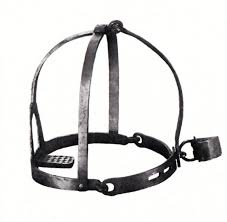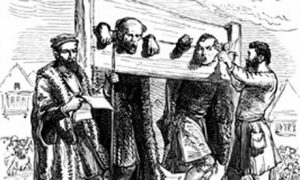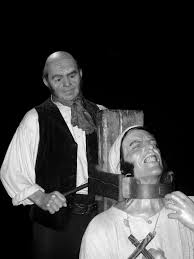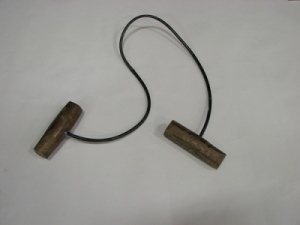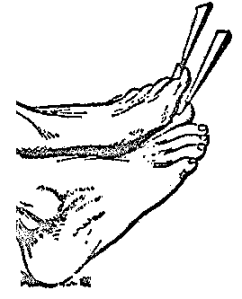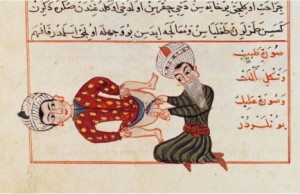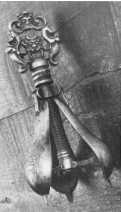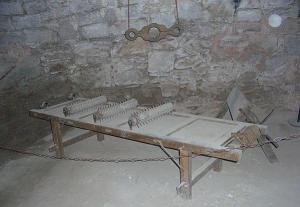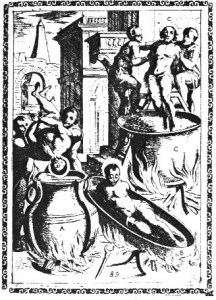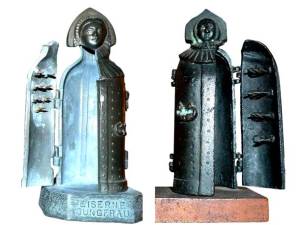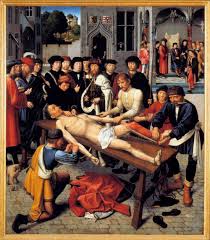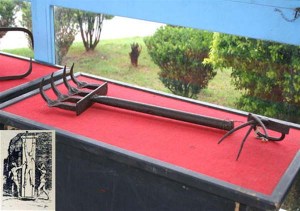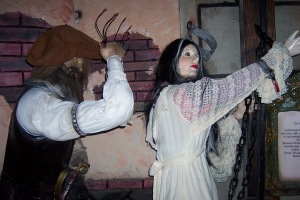With the entertainment industry buzzing over the release of Fifty Shades of Grey last month (a movie about a relationship which nudges the practice of BDSM – Bondage, Domination, Sado-Masochism), I decided to dedicate this blog to earlier forms and uses of whips and devices – quite possibly the roots of BDSM?
In the words of Chrissy Amphlett from Australia’s 80’s rock group, Divinyls, ‘it’s a fine line between pleasure and pain,’ and whilst Fifty Shades looks at the pleasure, I shall look at the other side – a very real part of life in the Middle Ages – medieval torture.
Read on, if you dare…
(Because of the nature of this post, reader discretion is strongly advised. I do warn you it is not for the faint-hearted.)
Torture in the medieval ages was a brutal reality. The word ‘torture’ comes from the Late Latin tortura, past particle of torquere meaning ‘to twist’ and torture relied upon devices which applied pressure to the body as the Church discouraged the shedding of blood.
It existed either as a punishment for a serious misdemeanour or to extract necessary information from the unfortunate victim and, by exhibiting the most horrendous methods publicly upon the crowds, it was to act as a deterrent to society. It was deemed a legitimate means to extract confessions or to obtain the names of accomplices or other information about a crime. In earlier civilisations, a slave’s testimony was only admissible if it had been gained by torture. What is disturbing was that some creatures actually injected a sense of creativity into the creation of some devices designed to inflict pain. Some of the examples included here were outright death sentences but not without including a great deal of torture first.
When I began to write this, I did expect to separate some of the tortures that had been ‘grouped together’ – after all I wanted to make it divisible in ‘shades.’ But most cases are significantly different to each other, albeit sometimes a collection of these tortures were used together upon a single victim. What I did not expect was to get to the number of fifty! And I did – quite easily.
In fact, in keeping with the title and to stay at fifty, I had to double some up and drop some information off but the discarded ones could probably be better described as outright executions – the exception I made being ‘burned at the stake,’ which involved much torture before death took the victim and it covered the topic of fire, so I have included it.
Out of all the blog posts I have written, this has been the hardest so far and not for the work it entailed but because it’s difficult to read and write of such things and not to feel some compassion for those poor souls, innocent or guilty, who had to endure such horrors and so much pain.
I have tried to put them in some sort of order – possibly ‘least’ to ‘worst’ – with the exception of those grouped together in shades of similarity (eg. water torture) or the body parts used and, in order for the reader not to be overcome by despair, I have inserted some light-hearted sketches in between.
Please note: Where possible, gender-based devices will be noted, and though many tortures were for both sexes, I will simply refer to victims as male.
It is not expected that you will read this entry all in one hit. After all, it’s a pretty grim subject and 50 examples long, but that’s the great thing about blogs. You can revisit in your own time.
You can also be thankful that you do live in ‘this time.’ These tortures were a very real part of life for those who lived in medieval times.
1. Thumbscrew
The thumbscrew or ‘pilliwinks’ were designed to slowly crush the fingers and toes. Larger devices (picture in red) were used to crush knees and elbows. The primary intention was to extract confessions from victims.
2. The Head Crusher
The head crusher served the same purpose as the thumbscrew. It would slowly and painfully crush the head.
3. The Scold’s Bridle or Brank (Used in ‘The Order of the Lily’)
The device was a metal cage which enclosed the head. It included a bridle-bit or a spiked plate, about two inches long, which was projected into the mouth to press down upon the tongue in order to make speaking impossible. It was used to humiliate women, particularly gossipers.
4. The Pillory or Stocks (Used in ‘The Gilded Crown’)
The pillory was used to restrain a victim for public humiliation, sometimes coupled with flagellation (whipping – see no. 20). Usually placed in a busy marketplace, the crowd could throw harmless objects such as rotten vegetables and animal dung, or if the offense warranted, sharper objects such as stones. The offender was defenseless against other humiliating acts such as the cutting of his hair, marking his body and, for the more zealous, mutilation.
5. The Scavenger’s Daughter
The Scavenger’s Daughter worked by compressing the victim’s body. The torturer could tighten or loosen the device, depending upon the severity of the crime. Although not painful-looking, this device was used to publicly humiliate a victim who was at the mercy of the crowd. If the torture was used over a prolonged period, it would lead to madness and starvation.
6. Abacination
Abacination is a form of of torture in which the victim is blinded by having a red-hot metal plate held before their eyes. A corrosive chemical, typically slaked lime, was contained in a pair of ‘cups’ with decaying bottoms of parchment/leather. The cups were strapped in place over the prisoner’s eyes as he was bound in a chair. The corrosive agent slowly ate through the cups and then the eyeballs. It is a very old form of punishment and was recorded in ancient Persia.
7. Tongue Tearer
Looking like an oversized pair of scissors, the ‘tearer’ could effortlessly cut the victim’s tongue. Their mouth would be forced opened with a device called a mouth-opener (ingenious name) and then the iron tongue tearer would uncomfortably twitch the tongue with its rough grippers. Once a firm hold was maintained, the screw would be firmly tightened and the victim’s tongue would roughly be torn out.
8. Neck Spike
This punishment was a test of endurance where the victim would be fitted into a neck device, either made of metal or wood, which prevented the victim from adjusting into a comfortable position. They were unable to lie down, eat, or lower their head for days.
9. Heretic Fork
This torture device consisted of a metal piece with two opposed bi-pronged forks attached to a belt or strap. One end of the device was pushed under the chin, the other to the sternum, and the strap was used to secure the victim’s neck to the tool while the victim hung from the ceiling or was somehow suspended so that they could not sleep. If their heads dropped, the prongs would pierce their throat and chest.
10. The Garotte
The Garrotte received its Spanish name due to its popularity in the area (widely used during the Spanish Inquisition). The Spanish also perfected this instrument so it would cause a painful and decisive death.
The victim was tied to the instrument and his neck forced inside the iron collar. With the handle that can be seen in the picture, the executioner slowly crushed the victim’s neck causing death from asphyxia. A simple version of garotte could be used by anyone to outright strangle a person.
11. The Spanish Spider or The Breast Ripper
This device was designed especially for women. Used to cause major blood loss, the claws, which were often red hot, would be placed on the exposed breasts as the spikes penetrated beneath the skin. It would then be pulled or jerked causing large chunks of flesh to come off with it. Another version, ‘The Spanish Spider,’ was used during the Spanish Inquisition. The spider was usually chained to the wall – the claws were heated before being fixed to the woman’s breasts. The torturer would pull the woman away from the wall to remove her breasts. This was a brutal punishment that often resulted in the victim’s demise.
12. Denailing
A common method of torture to extract information from the victim. He would be restrained in a position that allowed the torturer full access to the victim’s toes. Depending on the importance of a confession, the torturer could choose to extract each nail rapidly or to extract it as slowly and painfully as possible.
The instruments required for this torture method could be found anywhere, which made it incredibly popular. Additionally, if required and applied correctly, this method could be extraordinarily painful but leave no permanent damage.
Denailing was widely used during the Spanish Inquisition to extract confessions from heretics. This torture method is still being used today in certain countries.
13. Finger and Toe Wedging
Wedging became popular hundreds of years before the Middle Ages; its origins probably date to Ancient Egypt. It was used almost exclusively for confessionary purposes.
The victim’s feet or hands were secured on a small platform. Using wooden or metallic wedges, the torturer slowly fixed the wedges underneath the victim’s nails. What followed next was agonizing pain for the victim. Failure to confess would mean wedging the next nail, and the next.
Toe/finger wedging was considered the prelude to more painful and humiliating torture methods that would ensue if the victim still failed to confess. Since the same wedges were used on several victims, it was common for infections to result, leading to amputations and even death.
14. The Copper Boot
The copper boot could be used in a few different ways. First, the torturer placed the victim’s feet inside the boot and secured them with chains. Torturers could then fill the boot with water and place a fire beneath the feet. Another way was to repeatedly beat the boot with a hammer. Although the legs would not suffer lethal damage, the pain this incurred often made the victim pass out. Also they could fill the boot with molten metals. This would result in third degree burns and intoxication, but it also rendered the boots useless for another victim.
15. Mutilation and Castration
Castration is where the male loses the use of his testicles which causes sterilisation – the inability to reproduce. It also reduces the production of the male hormone, testosterone. In a male-dominated society, where reproducing an heir was a major factor to ‘normal’ lifestyle, the psychological effect would be profound.
One famous victim of castration was the medieval French philosopher, scholar, teacher, and (later) monk, Pierre Abélard. He was castrated by relatives of his lover, Héloïse.
Bishop Wimund, a 12th-century English adventurer and invader of the Scottish coast, was another victim of castration.
In the Byzantine Empire eunuchs were castrated so they would become a devoted personal servant, having neither family nor heirs to which to adhere. It also made them perfect to protect their lord’s harem for eunuchs were prevented by castration from feeling normal tendencies towards the women.
‘Guards! The upside-down prisoner has to pee!’
16. Strappado (Rope)
Strappado (aka ‘reverse hanging’) is where the victim’s hands are first tied behind his back, and then he is suspended in the air by means of a rope attached to wrists, which dislocates both arms. Weights may be added to the body to intensify the effect and increase the pain. While the technique shows no external injuries, it can cause long-term nerve, ligament, or tendon damage.
Another variant is the victim is dropped at intervals and then checked by the rope. The painful jerk would cause major stress to the extended and vulnerable arms, leading to broken shoulders. And a third deviation was to add heavy weights to the ankles. This will not only cause damage to the arms but also the legs and hips. This variant is known as ‘squassation.’
17. Crocodile Shears
The interior design closely resembles a tube containing numerous spikes on both ends. It was used to mutilate. The iron pincer was heated to red-hot before being clamped down onto the victim’s appendages, then tearing them from their bodies. Sometimes used on the fingers, its most common use was to mutilate a man’s penis, the arterial damage provoking death. It was said to be used on those who attempted to assassinate the king.
18. Pear of Anguish or Choke Pear (mentioned in ‘The Order of the Lily’)
This was used to punish liars, blasphemers, and homosexuals. The device was inserted into one of the prisoner’s orifices – the mouth for liars and blasphemers (which is why it’s also known as the Choke Pear); the vagina for women, and the anus for homosexuals. Some versions even had blades attached so when the pear was inserted, the blades could be rotated to cause internal bleeding. It was also used to torture women who were accused of facilitating a miscarriage.
19. Lead Sprinkler
The torturer poured molten metals in one end and its contents slowly rushed to the other side where they fell through the holes on any part of the victim’s body, even the eyes which resulted in agonising pain and eventually death.
20. Flagellation (Whipping)
Flagellation, or whipping, is probably the most common of punishments and many towns had a post in the main market area for the sole objective of displaying public whippings. In the Late Middle Ages, flagellation became less common due to newer torture methods.
The whipping generally occurred against the victim’s back, but when a more severe crime was committed his chest could be whipped, which was especially dangerous and painful. Plus there were different types of whips. Some had small metal spikes at the end to rip the skin faster and deeper, thus inflict more pain.
21. The Pendulum
The pendulum was a way of extracting confessions. With the same procedure as ‘Stappado,’ (the difference being there is a machine to do the work for you), the victim’s wrists were tied behind his back. As the torturer turned the handle, the rope slowly elevated the victim eventually dislocating his shoulders. This was seldom a lethal torture and many confessed merely at the sight of this device.
22. The Rack
Another common favourite during medieval times, the rack was designed to dislocate every joint of the victim’s body. It was made out of a wooden frame with two ropes fixed to the bottom and the other two tied into the handle on top. Once the victim was bound and placed on top of the rack, the torturer would turn the winch. The victim would be stretched until his limbs where dislocated. It was possible to keep turning the wheel until the limbs where completely torn off the victim’s body.
Sometime this method was limited to dislocating a few bones, but if the torturer went too far, it would render the legs or arms (sometimes both) useless. In the Late Middle Ages, some new variants of this instrument appeared. They often had spikes that penetrated the victim’s back. As the limbs were pulled apart, so was his spinal cord increasing not only the physical pain, but the psychological one of being permanently handicapped.
Many knights from the Knights Templar were tortured on the rack. It was reported ‘the limbs collected were emptied by the hundreds.’
‘You lucky, lucky bastard!’
23. The Picquet
The picquet was mostly used in the military as a way to maintain discipline throughout the army. The picquet didn’t require any sophisticated tools as all that was needed was placing a stake in the ground and tying the victim’s thumb far above his head. The stake was never sharp enough to draw blood, but it was meant to be very painful. Sometimes, the victim’s whole hand was tied instead of just his thumb to prevent major injuries.
When the victim felt that his thumb was about to dislocate, he would put his weight on the stake. On the other hand, placing too much weight on the stake would lead to much pain. Although this torture method was never meant to end in death, some draconian commanders ordered their victims to be subject to this torture for up to two days – sometimes incurring death.
This method became less popular with the introduction of other more visually-striking torture methods during the Late Middle Ages.
24. Exposure
As its name implies, this method consists of exposing a victim to the elements. The victim could be buried up to his neck or tied to a post, letting any animals, insects or other people kill him slowly. In some towns there were permanent chains, stocks or ropes that were used to restrain someone. In many cases, the victim was simply left to die of hunger and thirst.
Due to its cost efficiency and cruelty, the exposure torture was very widespread in medieval Europe. The victim’s remains often served as a warning to the people.
25. Water torture
A very painful method of torture consisted of fixing a victim’s head under a small tube that constantly filtered drops of water. These fell on the same spot of the victim’s head leading to, in prolonged periods of time, perforation and eventually death.
26. Freezing with water (No Picture)
In the winter, the naked victim was forced to stand outside in full view of everyone. The torturer poured water on his head which eventually became frozen, making the victim die slowly and painfully. Sometimes the body was left for the whole winter to terrify the population and dissuade any further crimes, as punishment was imminent.
A variant was to douse the victim’s limbs with cold water, to speed up the onset of frostbite. This was done until the limbs were hard enough to elicit a ringing sound when they were hit with sticks. Afterwards, they could either have their limbs and fingers smashed off or immediately defrosted by hot water which caused all the flesh on the limbs to just slide off.
27. Forced Drinking
This torture was simple and effective. A tube is forced over the victim’s mouth and he is forced to drink huge amounts of water until he either confessed or drowned.
28. Keelhauling
The earliest official mention of keelhauling is from the Greeks in the Rhodian Maritime Code (Lex Rhodia), of circa 800 BC, which outlines punishment for piracy. It is also pictured on a Greek vase from the same era.
The sailor was tied to a line that looped beneath the vessel, thrown overboard on one side of the ship, and dragged under the ship’s keel, either from one side of the ship to the other, or the length of the ship (from bow to stern). As the hull was usually covered in barnacles and other marine growth, if the offender was pulled quickly, keelhauling would typically result in serious cuts, loss of limbs and even decapitation. If the victim was dragged slowly, his weight might lower him sufficiently to miss the barnacles, but this method would frequently result in his drowning.
*29. Cucking Chair /stool (Ducking) (Used in ‘The Order of the Lily’)
This was a favoured torture to use on women. The victim was tied to a chair and elevated by ropes above a pond or river. She was lowered into the water until completely submerged. The chair could be raised if the victim was about to pass out, or to give the victim a chance to confess.
This method was widely used during the Spanish Inquisition and in England and France.
30. Boiling
The unlucky victim was placed inside an empty cauldron. The cauldron was filled with cold water and beneath it, a fire was set. Eventually the water began to boil, cooking the live victim. This was usually a death sentence but not without a lot of torture first.
31. Tar/Pitch and Feathering
The earliest mention of the punishment appears in orders that King Richard I issued to his navy on starting for the Holy Land in 1189. The order indicated that any thief or felon, being lawfully convicted, shall have his head shorn, boiling pitch poured upon his head and topped with feathers or straw so that he will be known for his misdemeanour. Upon landing, the victim would be ‘cast up.’
32. Branding
There were various methods with branding. A red-hot brazier could be passed backwards and forwards before the eyes until they were destroyed by the scorching heat. Red hot pokers were applied to various parts of the body or various marks branded into the flesh using irons.
A branding iron had a long bolt with a wooden handle at one end and a brand at the other. Two iron loops were used for firmly securing the hands during the excruciating process of branding, the victim often falling unconscious at the horrendous odour of burning flesh.
33. The Brazen Bull/ The Crocodile Tube
Also known as the Sicilian Bull, it was designed in ancient Greece. A solid piece of brass was cast with a door on the side that could be opened and latched. The victim would be placed inside the bull and a fire set underneath it until the metal became literally yellow as it was heated. The victim would then be slowly roasted to death all while screaming in agonizing pain. The bull was purposely designed to amplify these screams and make them sound like the bellowing of a bull.
*May be seen in the movie Red Riding Hood.
The crocodile tube followed the same principal except the victim’s head and feet were left exposed so torture to these parts could be applied before the fire was lit. Facial mutilation and toe ripping were preferred choices.
34. Scaphism – (The Tub or the Boat)
Scaphism, also known as the boat, was an ancient Persian torture/death; the word meaning ‘scooped or hollowed out.’ The victim was placed, naked, within the interior of two boats or hollowed out tree trunks (later a tub), with only head, hands and feet protruding. They would be forced to ingest milk and honey to the point of developing a severe diarrhoea. More honey was poured on them to attract insects. They would lie in their own waste with insects feeding and burrowing into their flesh, eventually dying of dehydration, starvation, and septic shock. Delirium would typically set in after a few days.
35. The Coffin or Crow’s cage
The Coffin torture was feared throughout the Middle Ages and when you see one, you realise why.
It involved placing a victim inside a metal cage roughly the size of the human body. Torturers also forced overweight victims into smaller cages to heighten their discomfort as they hung from a tree or gallows. The period of time a victim was kept inside the coffin was determined by his crime. Very serious crimes were punished by death. The victim would be kept outside, under the sun, with animals able to eat their flesh, usually crows, hence the device’s other name of a ‘crow’s cage.’
36. The Iron Maiden
This torture device consisted of an iron cabinet with a hinged front and spike-covered interior, sufficient enough to enclose a human being. Once inside its conical frame, the victim would be unable to move due to the great number of steel spikes penetrating the victim’s flesh (but missing vital organs) with the strategically-placed spikes. When completely closed, the screams from the victim could not be heard outside, nor could the victim see any light or hear anything from within. This increased the psychological pain. Additionally, the spikes blocked the wounds so it took many hours – or even days – for death to occur.
If the door was opened, the victim would stand in the same position so if the torturer chose to close the door again, the spikes would penetrate the exact same wounds.
Sometimes the door was intermittently opened and closed to maximise the victim’s pain without delivering death.
Although the ‘Iron Maiden’ is often associated with the Middle Ages no actual account prior to 1793 has yet been found.
37. Sleep Deprivation/Psychological
Psychological torture has its place among the list and no worse can be found than simple sleep deprivation. It has been said that a human can live longer without food or water than they can without sleep.
In stark contrast to torture that inflicts physical pain, psychological torture is directed at the psyche with calculated violations of psychological needs, along with deep damage to psychological structures and the breakage of beliefs, underpinning normal sanity.
Psychological torture includes deliberate use of extreme stress and situations such as mock execution, shunning, violation of deep-seated social or sexual norms and taboos, or extended solitary confinement as well as the lack of sleep. Such deprivation would cause cognitive inability, memory lapses or loss, tremors, aches, severe yawning, hallucinations and increased heart rate until eventually the body shuts down.
38. Starving and Immurement (Walled in)
Historically, starvation has been used as a death sentence. From the beginning of civilization to the Middle Ages, people were immured, or walled in, and would die for want of food. The process was simple. Put them in a niche or chamber and brick them in.
In Sweden in 1317, King Birger of Sweden imprisoned his two brothers for a coup they had staged against him. Supposedly, the king threw the key into the castle moat and the brothers died of starvation a few weeks later.
Another famous unsolved ‘starvation’ in the 14th C is that of King Richard II. Imprisoned by his cousin, Henry of Bolingbroke, it is unclear to this day if Henry starved Richard or the depressed, deposed king simply refused to eat.
39. Pressing or Pienne forte et dure
Peine forte et dure, meanng ‘hard and forceful punishment’ was a method of torture formerly used in the common law legal system, in which a defendant who refused to plead and stood mute would be subjected to having heavy stones placed upon their chest until a plea was entered or, if the weight of the stones on the chest became too great for the condemned to breathe, fatal suffocation would occur.
A criminal justice system that punished only those who volunteered for punishment was unworkable so this was used to coerce some response. The victim would lie upon his back with his head covered, his body spread-eagled and held by ropes/chains. Then heavy stone would be piled, one at a time, upon his chest until he could bear no more.
Many defendants charged with capital offences refused to plead, since by refusing they would escape forfeiture of property, and their heirs would still inherit their estate. If the defendant pleaded guilty and was executed, their heirs would inherit nothing, their property escheating to the Crown. That’s why it was vital to the Crown to get a plea.
‘Are there any women here today?’
40. Rat Torture
One of the most sadistic of all torture techniques (and cheapest) involved having a cage with one open side strapped against the victim’s body, usually over the intestines. It would then be filled with large rodents. A heating element was placed on the other side of the cage and the rodents’ natural instinct led them to flee the intense heat. In order to escape they would burrow through the victim’s stomach, find the intestines, and dig their way out of the victim’s body with fatal results. This took a few hours of agonising pain for the victim.
Rat torture as applied in ‘Game of Thrones’
41. Spiked Chair
Also known as the Judas Chair, it was a terrible, intimidating torture device that was added to dungeons in the Middle Ages. Used in Europe until the 1800’s, this chair was layered with 500 to 1,500 spikes on every surface with tight straps to restrain its victim. Made of iron, it could also contain spaces for heating elements beneath the seat. It was often used to scare people into giving confessions as they watched others being tortured on the device.
The time of death greatly varied ranging from a few hours to a day or more. Similar to the Iron Maiden, no spike penetrated any vital organ and the wound was closed by the spike itself which delayed blood loss greatly.
42 The Breaking Wheel (The Catherine Wheel)
Also known as the Catherine Wheel, this is a torture device used to slowly kill the victim. First, the victim’s limbs were tied to the spokes of a large wooden wheel which would then be rotated as the torturer simultaneously smashed the victim’s limbs with an iron hammer. As the bones were broken, the victim would be left on the wheel to die or could be placed on top of a tall pole so the birds could feed on their flesh while still alive.
When Catherine of Alexandria refused to give up her Christian belief (c 305) she was scourged and imprisoned. Still refusing, she was tortured to make her yield but the breaking wheel broke at her touch. Ultimately, she was beheaded but the breaking wheel then became known as ‘the Catherine Wheel’ in her honour.
43. Judas Cradle
Closely related to impalement, this gruesome punishment entailed having the victim sit on the pyramid-shaped cradle, after which they would be forced down on it by ropes with the intent of stretching the victim’s anus or vagina over a long period of time, slowly impaling them. Sometimes weights would be added to the victim’s legs or oil added to the device, which would increase the pain considerably. To add to the overall humiliation, the victim was usually naked and the device was rarely washed. So if the torture did not kill you, the infection contracted from it would.
44. Spanish Donkey
One of the torture devices used during the Spanish Inquisition. The victim is put astride, naked, on a donkey-like apparatus, which is actually a vertical wooden board with a sharp V-wedge on top of it. After that, the torturer would add varying weights to the victim’s feet until finally the wedge sliced through the victim’s body.
45. Impalement
The victim was forced to sit on a sharp and thick pole. When the pole was then raised upright, the victim was left to slide down the pole with their own weight. It could take the victim 3 days to die using this method.
In 1436, Vlad III, ascended the throne of Wallachia in Romania and was later given the title ‘Vlad the Impaler’ for having impaled 20,000 people during his lifetime.
46. Crucifixion
Principally practiced in antiquity, it is one of the most well-known execution methods due to the crucifixion of Jesus Christ. It is a deliberately slow and painful torture where the condemned person is tied or nailed to a large wooden cross and left to hang until they die, which usually takes days.
‘Next. Crucifixion? Good. Out of the door, line on the left, one cross each.’
47. Flaying and The Spanish Tickler (mentioned in ‘The Lily and the Lion’)
The victim was laid upon a table, his arms tied to a pole above his head while his feet were tied below. His body was now completely exposed and the torturer, with the help of a small knife, slowly peeled off the victim’s skin. In most cases, the torturer peeled off the facial skin first, working his way down to the victim’s feet. Most victims died before the torturer even reached their waist.
The Spanish Tickler was an instrument that could ‘rake’ the skin from the body. Due to its shape, neither bone nor muscles were spared. Another device used during the ‘Spanish Inquisition.’
48. Saw Torture
In this method, the victim is hung upside down, so that the blood will rush to their heads and keep them conscious during the long torture. The torturer would then saw through the victims’ bodies until they were completely sawed in half. Most were cut up only in their abdomen to prolong their agony.
49. Burning at the Stake (Used in ‘The Gilded Crown’)
Burning at the stake was a very common way to execute heretics in the Middle Ages.
If the fire was big enough, death occurred first by asphyxia rather than by the flames. However, this was a known fact and the victims were usually burned in a smaller fire so they would suffer until the end.
When the fire was small, death occurred because of loss of blood or a heatstroke which could take hours. Occasionaly (with a gold coin or two) a gesture of mercy would see the executioner step behind the pole during a smoke cloud and discreetly strangle the victim but only if the flames did not endanger him.
The smell of burned flesh was terrible and lasted for many hours or even days after death. Hundreds were burned at the stake during the Spanish Inquisition.
Joan of Arc and many of the Knights Templar met this fiery end. (Pictured above)
50. Hanged, Drawn and Quartered
The penalty for high treason in England was to be hanged, drawn and quartered in public and though it was abolished in 1814, it has been responsible for the death of thousands of people. In this torture technique, the victim is dragged in a wooden frame called a hurdle to the place of execution. They would then be hanged by the neck for a short period of time until they are near-death (hanged) followed by disembowelment and castration where the entrails and genitalia are burned in front of the victim (drawn). The victim would then be divided into four separate parts and beheaded (quartered). Many heads were spiked on the London Bridge.
Some famous victims of this terrible torture were William Wallace and Hugh le Despenser the Younger. (Hugh pictured above on ladder)
On 24 November 1326 Despenser was roped to four horses and dragged through the city to the walls of his own castle, where enormous gallows had been specially constructed. Despenser was raised a full 50 feet and then lowered onto a ladder. A man climbed along side him, sliced off his penis and testicles and flung them into a fire below. He then plunged a knife into Despenser’s abdomen and cut out his entrails and heart. The corpse was lowered to the ground and the head cut off. It was later sent to London, and Despenser’s arms, torso and legs were sent to be displayed above the gates of Newcastle, York, Dover and Bristol.
So, you made it to the end of my version of ‘Fifty Shades’ – Congratulations! In that case, celebrate that in the western world in the 21st century, you do not have to worry about your body being subjected to such tortures.
By Catherine T Wilson.






